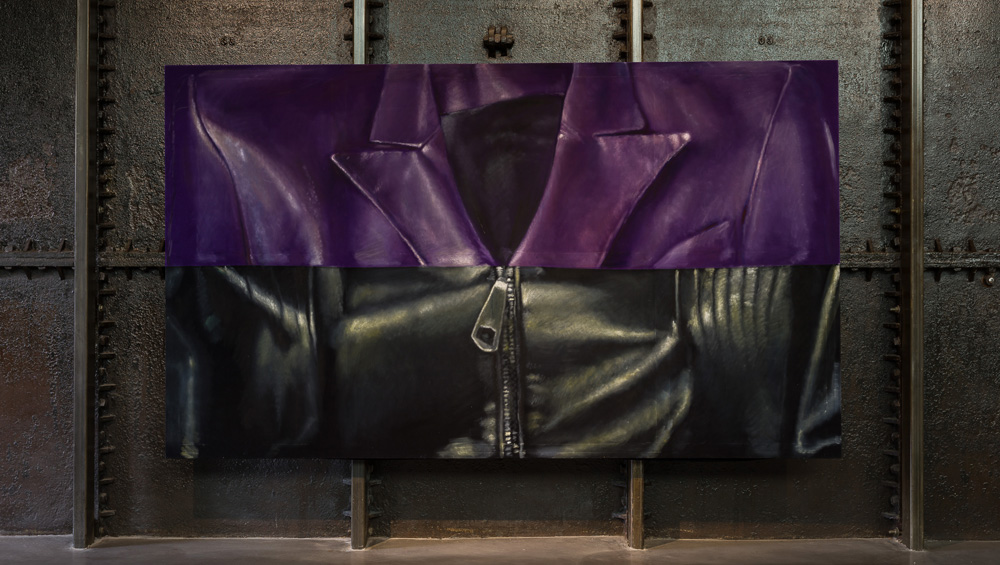
Issy Wood, Light layers / go, Daddy 3, 2019. Courtesy the artist and Carlos/Ishikawa, London. Installation view, Goldsmiths Centre for Contemporary Art, 2019. Photo: Mark Blower.
Goldsmiths Centre for Contemporary Art, London
29 June – 11 August 2019
by JULIA SCHOUTEN
A tweet from 2015 that had stuck with me resurfaced earlier this year: “I’m sad but not like sad enough to be a good painter or whatever.” It captures the pervasive view that artists must suffer to make “good” art, and highlights how much the public idolises a sad painter. We consumers of art, love – almost need – to interpret a painting (or other medium) through the lens of, usually carefully curated, biographical titbits about the artist that point to their personal trauma.
Issy Wood seems conscious of this desire for, and fetishisation of, the sad painter. She plays up to our longing, responding with her own acerbic brand of “sad painting”. Her works in All The Rage, now on view at Goldsmiths Centre for Contemporary Art, employ a sombre, muted palette and flirt with a surrealist visual language that teases the willing viewer, offering “clues” with which to decode her content and (hopefully, sad) psyche. In the same way, the show’s accompanying publication, filled with blog-like diaristic syntax, continues the illusion of reader-as-confidant.
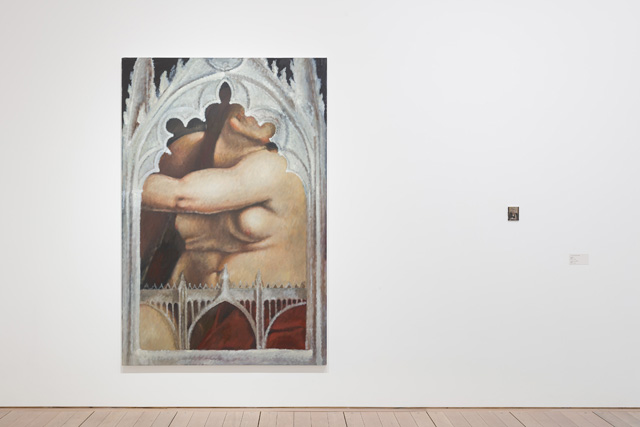
Issy Wood, All The Rage, installation view, Goldsmiths Centre for Contemporary Art, 2019. Photo: Mark Blower.
While Wood’s paintings and writing evoke the surreal illogic of dreams, they should not be read as repositories of her unconscious. They are more like reflections of her Instagram “ad interests”.1 Just as your ad interests are supposedly personalised, Wood’s compositions are compiled and conceived by her, but the final results are playful and deceitful. It is not that she is removed from the work entirely, more that there is enough artifice to obscure the sincere (biographical) insight that we so desperately tend to seek.
Much like her writing – which oscillates between what seem like real experiences, uncanny juxtapositions and falsified statistics – her paintings maintain an amused detachment. They resemble a form of cognitive interaction induced by social media, wherein everything – bodies, objects, cultural artefacts, current events, feelings – is experienced as ephemeral, increasingly meaningless stimuli.

Issy Wood, All the rage 1, 2019. Courtesy the artist and Carlos/Ishikawa, London.
In the painting All the Rage 1, one of the exhibition’s namesakes, Wood presents a closely cropped and grainy scene-like composition. A manicured hand steadily gripping a pistol emerges from between a pair of glinting cowboy boots, aiming at an invisible target. An old-fashioned wooden hairbrush and what looks like a handbag by the fashion label Shrimps cast long shadows over the otherwise vacant and darkened landscape. Three cute, bulbous clouds float innocuously among the objects, evoking a detached fog or evasive haze.
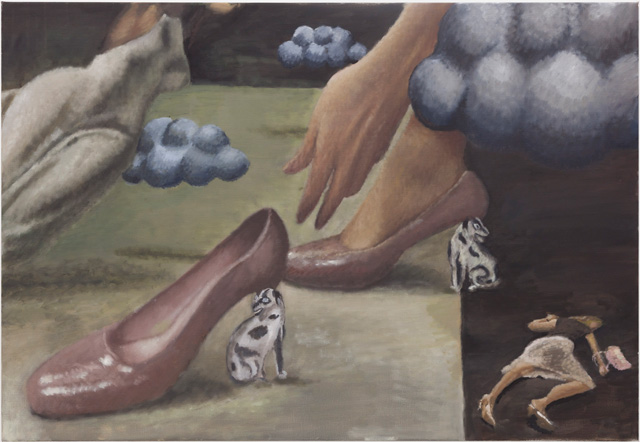
Issy Wood, All the rage 2, 2019. Courtesy the artist and Carlos/Ishikawa, London.
All the Rage 2, which is displayed in a different room, compositionally mirrors the first painting, as if a counterpart that depicts the fallout. To the left of the canvas, an aggressively cropped torso of a female figure appears to be mid-fall, perhaps caught by the bullet, while in the right-hand corner a woman is sprawled face-down on the ground. Between these two figures a lone foot wears one patent pink shoe with a dog-shaped heel, while a hand reaches down for the other shoe.
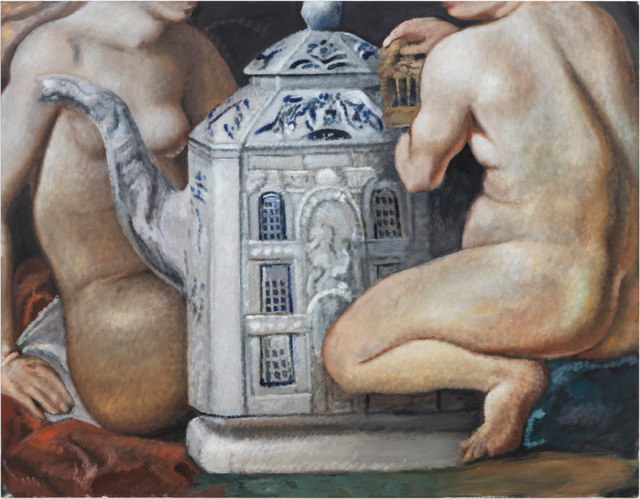
Issy Wood, The underdose, 2019. Courtesy of the artist and Carlos/Ishikawa, London.
Traces of violence are visible across both paintings, but at the same time they appear placid and indifferent. Because of this ambivalence, the gun becomes an almost harmless accessory, the fallen women conceivably victims of shopping and dropping. Within these two works and across the exhibition, objects and subjects are flattened, depreciated and homogenised. They are stripped of their original meaning and superseded by an overarching deadpan humour, maintained though titles such as: Sphinx Making the Best of a Seasonal Depression. The paintings emanate an apathetic alienation symptomatic of a networked, throwaway society.
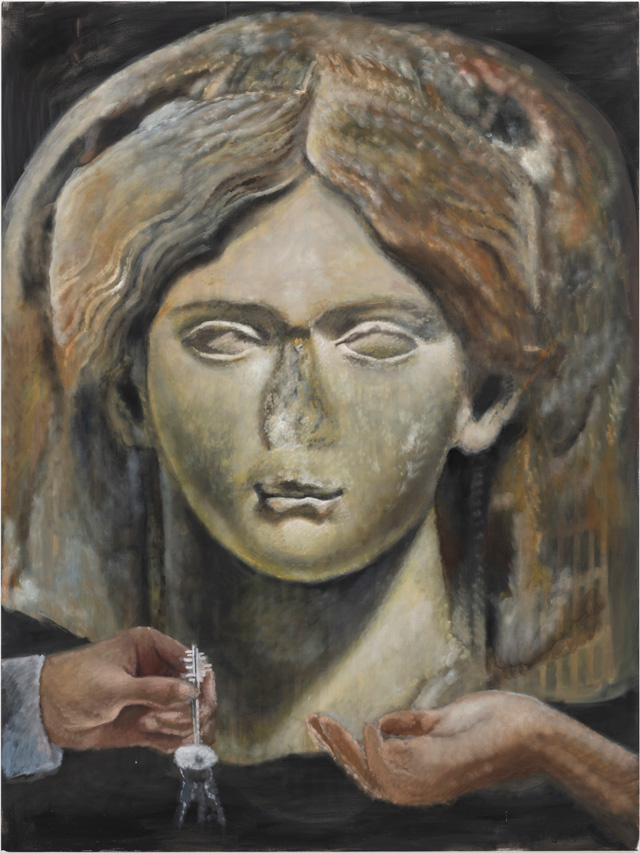
Issy Wood, Mother as docked idol with move-in date, 2019. Courtesy the artist and Carlos/Ishikawa, London.
The show’s accompanying press release explains that All The Rage is “a phrase which simultaneously suggests both unrelenting anger and a nod to what it is to be concerned with fashion”. The latter understanding is evident throughout Wood’s practice and the show. The artist dedicates equal attention to the identifiably “fashionable” and the “culturally valuable” as to gaudy luxuries and tat, suggesting that they are not mutually exclusive.
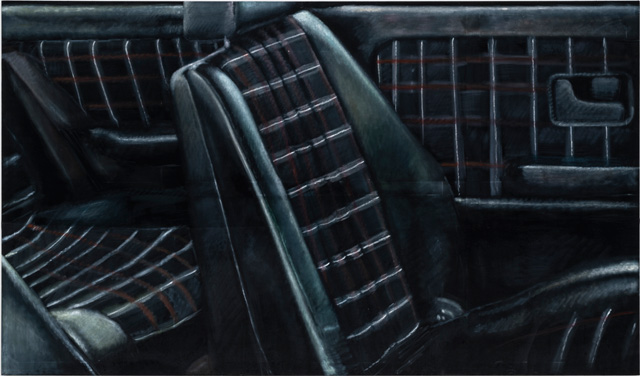
Issy Wood, Car interior / go, Daddy 2, 2019. Courtesy the artist and Carlos/Ishikawa, London.
Wood’s subject matter, ranging from car interiors and Russell Crowe’s flashy watches, to sphinxes and faceless art-historical nudes, raises questions about what is durably preserved and what becomes dated and obsolete. This point feels most present in Study for Good Will, a new installation of oil-on-clothing works, wherein Wood has painted on to “unsuccessful eBay purchases”: aliens, pills, dogs, clocks, keys, Greco-Roman heads, Joan Rivers, Mickey Rourke and a menorah adorn boots, bags, trousers, skirts, jackets and tops.
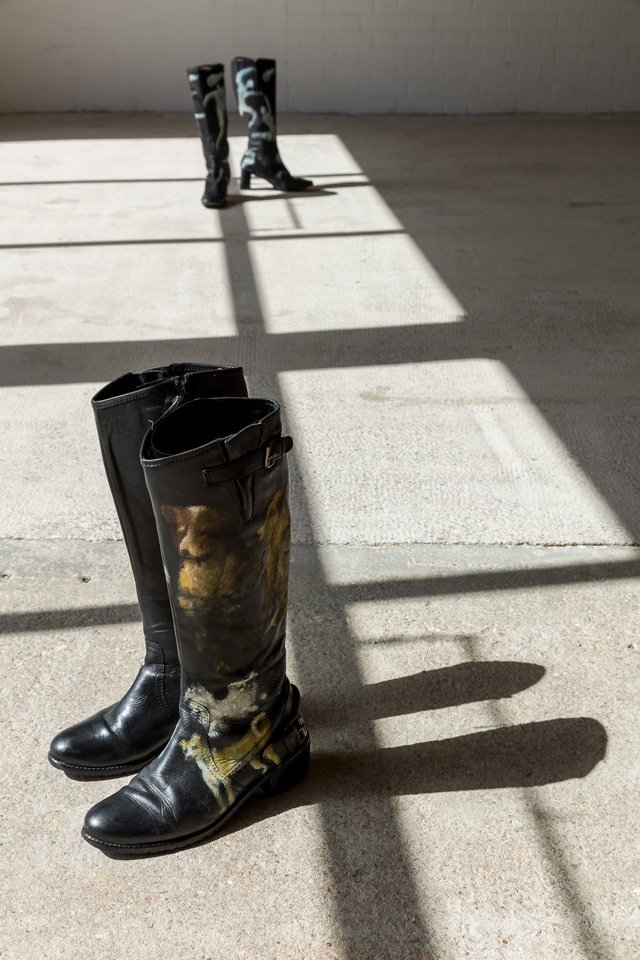
Issy Wood, All The Rage, installation view, Goldsmiths Centre for Contemporary Art, 2019. Photo: Mark Blower.
This method of working feels distinctly transient – not in the same way as a performance, but more susceptible to dating and decomposing than a “timeless” painting might be. Not only has painting been declared “dead” more times than I can count, or will the items of clothing be subject to “going out of fashion”, but the constitution of physical oil paint on these material surfaces makes you wonder how long the images themselves will stay intact.
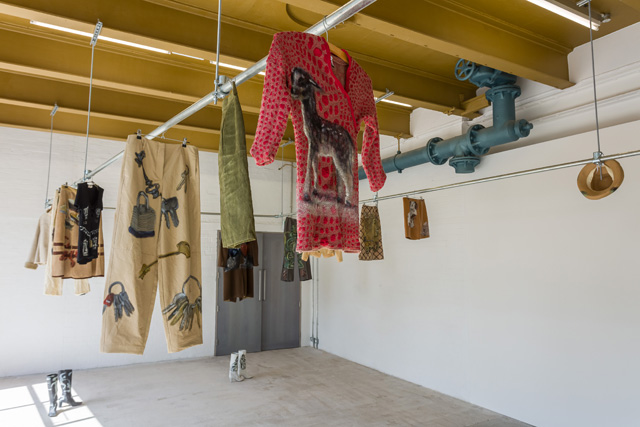
Issy Wood, All The Rage, installation view, Goldsmiths Centre for Contemporary Art, 2019. Photo: Mark Blower.
At the same time, the installation feels like a forthright affirmation of the obvious but often disguised reality that art (like clothing) is a commodity – durable or otherwise. Goldsmiths CCA is also selling editions of jackets on which Wood has painted zodiac signs. The installation and editions, taken alongside the artist’s depictions of opulent car interiors, for instance, emphasise that our definition and understanding of self is increasingly mediated by the things we buy.
All The Rage offers an ambivalent position, satirising the inexorable links of art, fashion, taste (or lack thereof) and luxury, while simultaneously creating (to put it crudely) luxury objects. This is not a new concept or stance within art, but what feels significant and successful about Wood’s take is her ability to capture the lobotomising effects of the easy pleasures of social media, celebrity cults, everyday consumption practices and unquestioned, dominant cultural values.
Reference
1. On Instagram, you can find your personalised ad interests by clicking on Settings > Security > Access Data > Ads. The result is a list of very strange words.